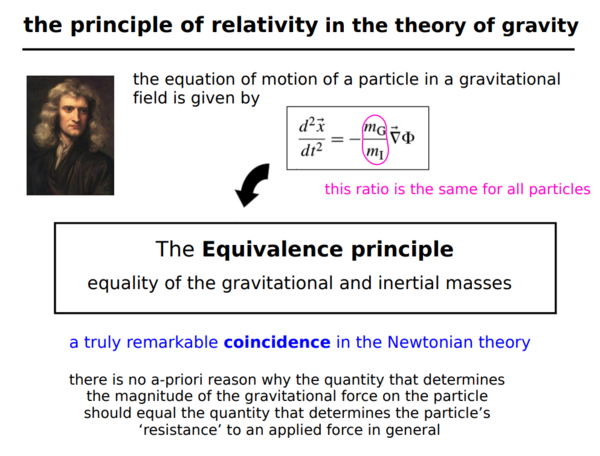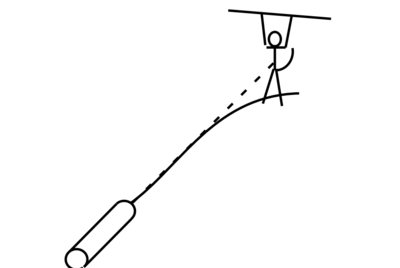Difference between revisions of "Equivalence Principle"
Tom Bishop (talk | contribs) |
Tom Bishop (talk | contribs) |
||
| Line 5: | Line 5: | ||
=Description= | =Description= | ||
| − | {{cite2|Whilst preparing a review article on his new special theory of relativity, | + | {{cite2|Whilst preparing a review article on his new special theory of relativity, [Einstein] became convinced that the key to the extension of the principle of relativity to accelerated motion lay in the remarkable and unexplained empirical coincidence of the equality of inertial and gravitational masses. To interpret and exploit this coincidence, he introduced a new and powerful physical principle, soon to be called the ‘principle of equivalence,’ upon which his search for a general theory of relativity would be based.|John Norton, What was Einstein's Principle of Equivalence? ([https://www.sciencedirect.com/science/article/abs/pii/0039368185900020 source])}} |
{{cite2|Einstein himself thought the equivalence principle deeply mysterious. ‘Mass,’ he wrote, ‘is defined by the resistance that a body opposes to its acceleration (inert mass). It is also measured by the weight of the body (heavy mass). That these two radically different definitions lead to the same value for the mass of a body is, in itself, an astonishing fact.’ Francis Everitt of Stanford put it more forcibly. ‘In truth, the equivalence principle is the weirdest apparent fact in all of physics,’ he said. ‘Have you noticed that when a physicist calls something a principle, he means something he believes with total conviction but doesn’t in the slightest degree | {{cite2|Einstein himself thought the equivalence principle deeply mysterious. ‘Mass,’ he wrote, ‘is defined by the resistance that a body opposes to its acceleration (inert mass). It is also measured by the weight of the body (heavy mass). That these two radically different definitions lead to the same value for the mass of a body is, in itself, an astonishing fact.’ Francis Everitt of Stanford put it more forcibly. ‘In truth, the equivalence principle is the weirdest apparent fact in all of physics,’ he said. ‘Have you noticed that when a physicist calls something a principle, he means something he believes with total conviction but doesn’t in the slightest degree | ||
Revision as of 23:18, 4 August 2020
The Equivalence Principle is a fundamental principle of physics which states that gravity operates as if the observer were in an upwardly accelerating frame of reference. Despite that it takes more force to move a more massive object through space (Newton's Second Law), when in free-fall all bodies 'fall' without exhibition of inertial resistance, just as if the Earth were accelerating upwards into inert bodies in space. The Equivalence Principle is also used to explain why observers in free-fall feel weightless and do not feel their weight pulling them down (ie. in a Zero G plane). Experiments with light and atomic clocks at various scales have further confirmed the nature of the Equivalence Principle.
“ There is no experiment observers can perform to distinguish whether an acceleration arises because of a gravitational force or because their reference frame is accelerating. ”
—Douglas C. Giancoli, Physics for Scientists and Engineers with Modern Physics, p. 155.
Description
“ Whilst preparing a review article on his new special theory of relativity, [Einstein] became convinced that the key to the extension of the principle of relativity to accelerated motion lay in the remarkable and unexplained empirical coincidence of the equality of inertial and gravitational masses. To interpret and exploit this coincidence, he introduced a new and powerful physical principle, soon to be called the ‘principle of equivalence,’ upon which his search for a general theory of relativity would be based. ”
—John Norton, What was Einstein's Principle of Equivalence? (source)
“ Einstein himself thought the equivalence principle deeply mysterious. ‘Mass,’ he wrote, ‘is defined by the resistance that a body opposes to its acceleration (inert mass). It is also measured by the weight of the body (heavy mass). That these two radically different definitions lead to the same value for the mass of a body is, in itself, an astonishing fact.’ Francis Everitt of Stanford put it more forcibly. ‘In truth, the equivalence principle is the weirdest apparent fact in all of physics,’ he said. ‘Have you noticed that when a physicist calls something a principle, he means something he believes with total conviction but doesn’t in the slightest degree
understand.’ ”
—Nigel Calde, Magic Universe - A Grand Tour of Modern Science, 2005
“ This equivalence of the gravitational and inertial masses (which allows us to refer simply to 'the mass'), is a truly remarkable coincidence in the Newtonian theory. In this theory there is no a-priori reason why the quantity that determines the magnitude of the gravitational force on the particle should equal the quantity that determines the particle's 'resistance' to an applied force in general. ”
—General Relativity: An Introduction for Physicists
From Introduction to Cosmology by the 4th Cosmology School at Cracow, Portland, we see:
Examples
Monkey and the Hunter
https://web2.ph.utexas.edu/~gleeson/RelativityNotesChapter8.pdf
8.3.1 The Monkey and the Hunter
“ There is a very popular demonstration that is performed in most high school and college introductory physics classes. There is a gun of some type that launches a projectile and a target object, usually a toy monkey, that can fall some distance. The gun and the monkey are rigged so that at the instant the gun fires the monkey is released to start to fall. ”
Figure 8.3: Monkey and the Hunter A popular lecture demonstration is to fire a projectile at a hanging toy monkey. The monkey is released at the instant that the gun is fired.
“ The class is usually asked where does the hunter aim. Since the monkey is falling, there is an argument that the hunter should aim below the initial position of the monkey to compensate for the finite time of flight of the projectile. On the other hand, the projectile has an arced trajectory and thus the aim should be above the current position. The correct answer is that the hunter should aim at the present position of the monkey. This is because once the gun is fired both the projectile and monkey are falling with an acceleration of g. In the frame accelerating down at a rate g, the effects of gravity are cancelled and thus neither the monkey nor the projectile have accelerated motion. In that frame, the projectile travels in a straight line and the monkey never moves. Note that if the aim is correct, no matter how small the projectile muzzle velocity, it will ultimately hit the monkey. This is an interesting pre-relativity example of the equivalence principle. ”
Science at the Amusement Park
https://web.archive.org/web/20200704180931/http://physics.gu.se/LISEBERG/callab.html
Carousel with Swings
“ A good starting point is the carousel with swings shown in Fig. 1. As the carousel rotates, the swings hang out from the vertical line, thereby enabling the chains to provide the force giving the required centripetal acceleration, while still counteracting the force of gravity. Take a moment consider which swings will hang out the most: the empty ones or the ones loaded with a child or with an heavy adult! In this situation students often pick the most heavily-loaded swings. They watch in amazement as the carousel starts - all swings (at the same radius) hang at the same angle, independent of load. ”
“ This is an eye-catching example of the equivalence principle: The angle is determined by the ratio between the centripetal force and the weight. Since the intertial mass (entering the centripetal force) and the gravitational mass (entering the weight, mg), are equal, the angle is independent of the mass. ”
General Relativity and Accelerating Upwards
The Equivalence Principle is a fundamental feature of General Relativity, which is interpreted to describe the surface of the Earth accelerating upwards through space-time to cause the EP effects experienced on Earth.
From Gravity: A Very Short Introduction by Cosmologist Timothy Clifton (bio), we read:
“ Consider a skydiver jumping out of an airplane. The skydiver falls freely, up to the effects of air resistance. According to Einstein, the skydiver's path is the straightest line possible through the curved space-time around the Earth. From the skydiver's perspective this seems quite natural. Except for the air rushing past her, the skydiver feels no perturbing forces at all. In fact, if it weren't for the air resistance, she would experience weightlessness in the same way that an astronaut does in orbit. The only reason we think the skydiver is accelerating is because we are used to using the surface of the Earth as our frame of reference. If we free ourselves from this convention, then we have no reason to think the skydiver is accelerating at all.
Now consider yourself on the ground, looking up at the falling daredevil. Normally, your intuitive description of your own motion would be that you are stationary. But again this is only because of our slavish regard to the Earth as the arbiter of what is at rest and what is moving. Free yourself from this prison, and you realize that you are, in fact, accelerating. You feel a force on the soles of your feet that pushes you upwards, in the same way that you would if you were in a lift that accelerated upwards very quickly. In Einstein's picture there is no difference between your experience sanding on Earth and your experience in the lift. In both situations you are accelerating upwards. In the latter situation it is the lift that is responsible for your acceleration. In the former, it is the fact that the Earth is solid that pushes you upwards through space-time, knocking you off your free-fall trajectory. That the surface of the Earth can accelerate upwards at every point on its surface, and remain as a solid object, is because it exists in a curved space-time and not in a flat space.
With this change in perspective the true nature of gravity becomes apparent. The free falling skydiver is brought to Earth because the space-time through which she falls is curved. It is not an external force that tugs her downwards, but her own natural motion through a curved space. On the other hand, as a person standing on the ground, the pressure you feel on the soles of your feet is due to the rigidity of the Earth pushing you upwards. Again, there is no external force pulling you to Earth. It is only the electrostatic forces in the rocks below your feet that keep the ground rigid, and that prevents you from taking what would be your natural motion (which would also be free fall).
So, if we free ourselves from defining our motion with respect to the surface of the Earth we realize that the skydiver is not accelerating, while the person who stands on the surface of the Earth is accelerating. Just the opposite of what we usually think. Going back to Galileo's experiment on the leaning tower of Pisa, we can now see why he observed all of his cannonballs to fall at the same rate. It wasn't really the cannonballs that were accelerating away from Galileo at all, it was Galileo that was accelerating away from the cannonballs! ”
See Also
Flat Earth Gravity Topics
- Universal Acceleration - The Universal Accelerator Main Page
- Evidence for Universal Acceleration - Experiments and background foundation showing that Earth is accelerating upwards
- Variations in Gravity - Various experiments have failed to find variations in gravity or violations of the Equivalence Principle
- Gravitational Time Dilation - Time dilates in accordance with the uniform prediction of the Equivalence Principal to various heights
Round Earth Gravity Topics
- Weight Variation by Latitude - An uncontrolled weight change experiment which is not performed in a vaccum chamber
- Cavendish Experiment - An inconsistent short range attraction experiment
- Gravimetry - Gravimeters are described to be seismometers by mainstream sources
- Isostasy - The mass attraction of mountains and continents does not behave in accordance with 'gravity'



